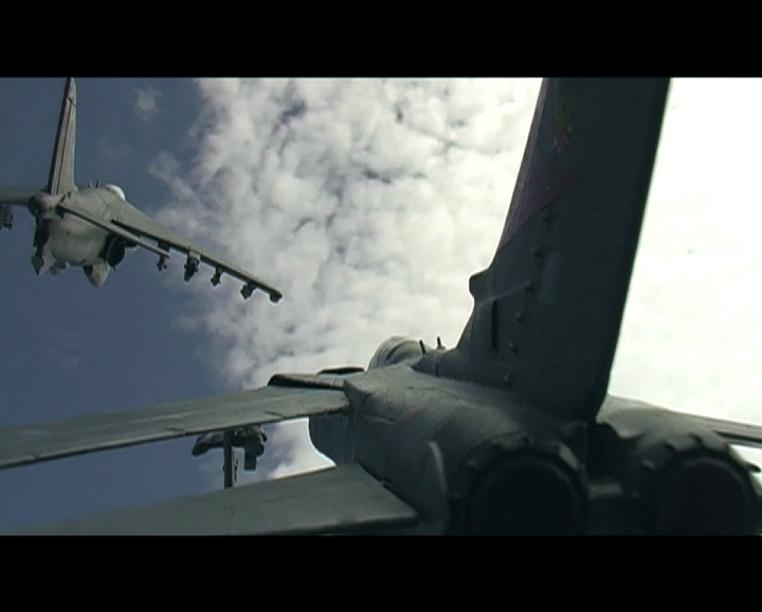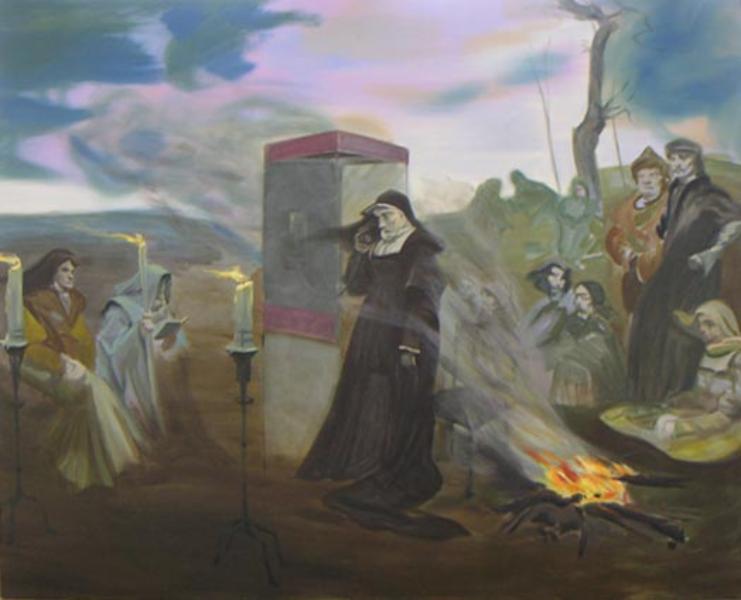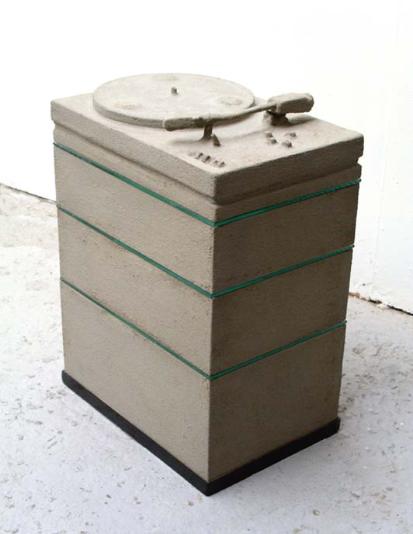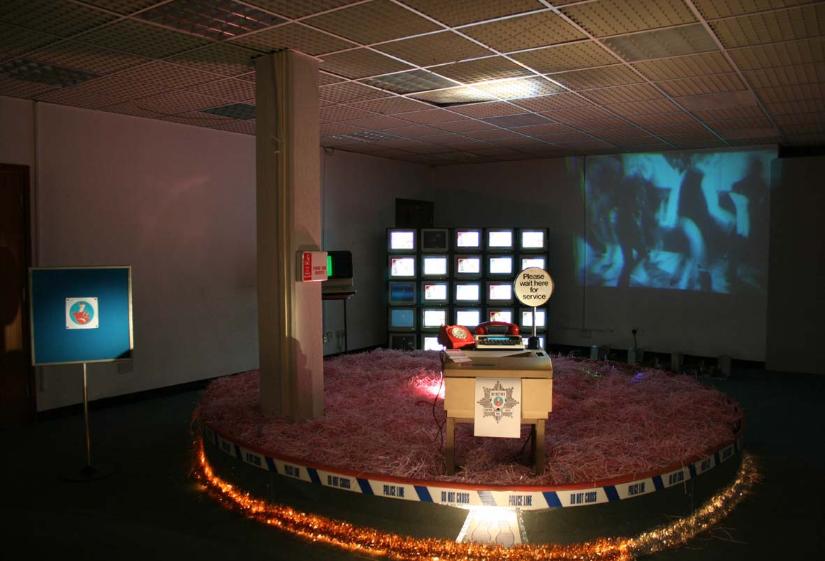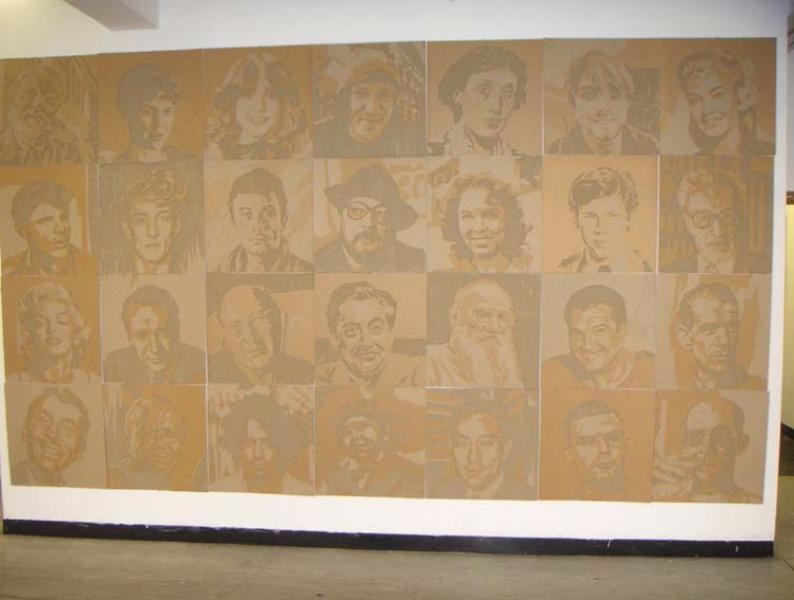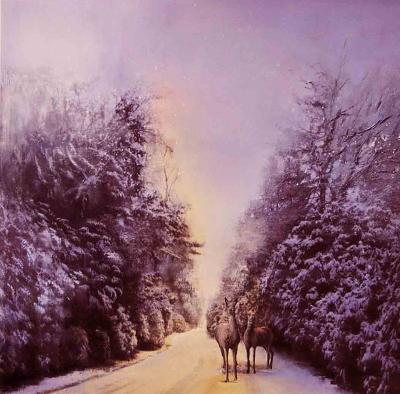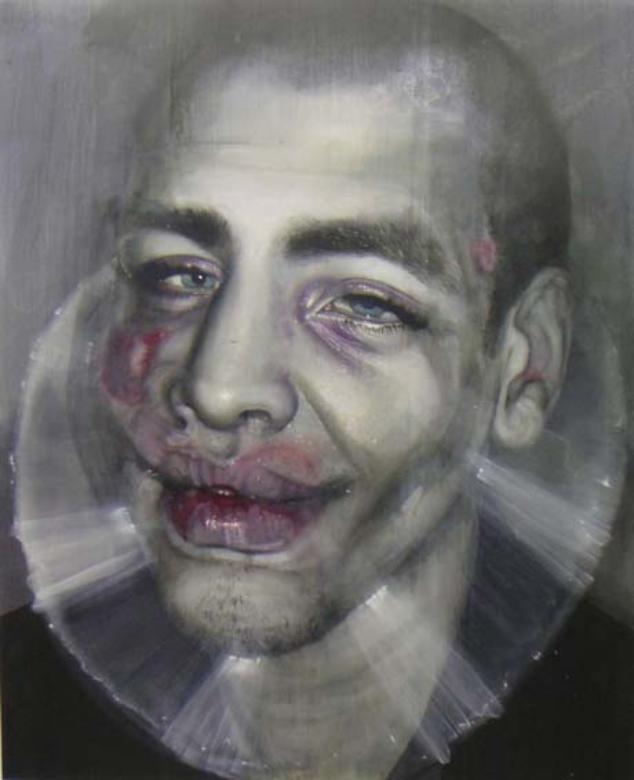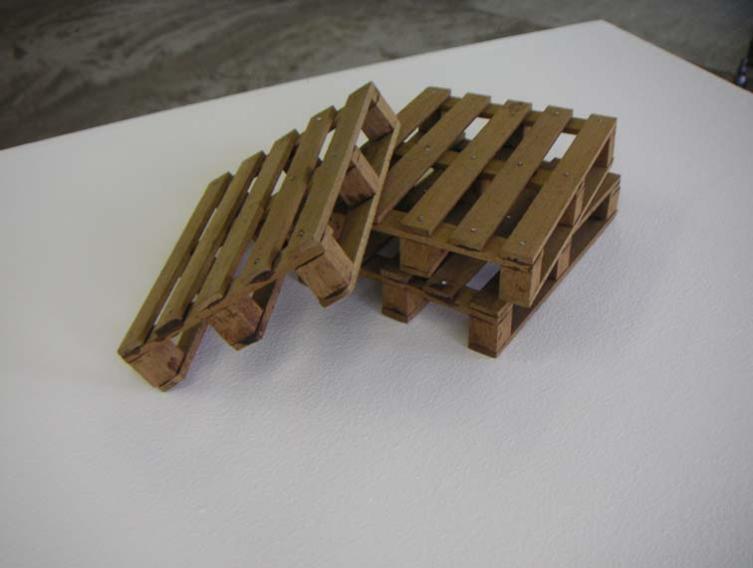Curated by Gretta Sarfaty Marchant and Richard Ducker
Exhibition: continues Friday, May 23 – Sunday, June 23 2006
Open: Friday, Saturday and Sunday 1 - 6pm
Radioactive decay rates are normally stated in terms of their half-lives, and the half-life of a given nuclear species is related to its radiation risk. The different types of radioactivity lead to different decay paths which transmute the nuclei into other chemical elements. The radioactive half-life for a given radioisotope is the time for half the radioactive nuclei in any sample to undergo radioactive decay. After two half-lives, there will be one fourth the original sample, after three half-lives one eight the original sample, and so forth.
This exhibition each address a notion of decay where each artist appears to represent it at different stages before entropy takes over. However hard it tries, art will always struggles to capture the present, and is therefore left playing catch-up. These artists exploit this state of affairs by exploring differing points of decay: half lives from moments that have past, ideologies lost. They reveal a world of physical or emotional instability, exploiting surface corruption to expose psychological wounds. Paint can either exquisitely open a world of illusion, while illusion can state an ugly opposite. Materials elegantly evoke a fading memory, or are assembled with precarious balance.
There is also a biological half life: the time required for half the quantity of a drug or other substance deposited in a living organism to be metabolized or eliminated by normal biological processes. Here at the beginning there is the possibility of elation and intoxication, at least before the process of the hangover begins. This exhibition attempts to represent some of these points on this arc: it is a world caught at various stages of transition from one state to another, in flux and on the edge of collapse.
Fieldgate Gallery a new 10,000 sq. feet gallery space under the Atlantis art shop, and a 10 minute walk from the Whitechapel Art Gallery. The nearest tube station is Aldgate East.
MAX ATTENBOROUGH
Maxwell Attenborough’s current work involves translating experiences of the real world into the hyper-real world of the miniature. The small world provides an opportunity to have, to control and to explore a situation and more importantly share it with the viewer. A principle fascination with the process involves making a fleeting moment permanent, allowing it to be analysed and become poetic in a cinematic sense. The model removes us in scale but pulls us into an intimate jewel- like situation. In recreating an event we take possession of it, and in combination with the miniaturisation of it we are distanced from it and as Gaston Bachelard states: “We possess from afar, and how peacefully.” Recent projects have resulted in short digital films that borrow heavily from cinema, but often show the model by itself. “When I show the model I relinquish some of the control that I have over the viewer, instead of dictating how the viewer approaches and experiences the model, they are free to discover it for themselves.”
CHRISTOPHER DAVIES
Christopher Davies' idiosyncratic work challenges
conventions of seeing. He looks out for strange, anthropological
scenarios witnessed in daily-life that stand out as extraordinary.
By sharing his observations of the world, Davies’ artworks
engage with the audience by presenting unexpected scenarios
that generate dialogues to perplex the viewer. Recently depicted
incidents include a woman carrying a dead dog across a T-
junction and a suited man riding a child’s scooter decorated with
a Halloween mask. The works are realized through small wooden
carvings, paintings and life sized equivalents of these memories.
RICHARD DUCKER
Richard Ducker explores the representation of obsolescence and nostalgia through the monumental, and became interested in creating artworks by which memory and the present collide. These works coalesce around certain themes, which articulates a notion of loss: a sense of displacement; narratives imagined, remembered, or real; the body as an absent presence; and a domestic disquiet. There is a muted quality, where any sense of mobility is associated with instability, and the insecurity of history. To this end, the use of materials combines the weight of concrete with the disposability of the everyday, establishing a dialogue between their formal presence, and associative past. They are made by either covering objects in cement, or incorporating cement within an ensemble of found materials.
LEE HOLDEN
Lee Holden has adopted the term "We Neither Confirm Nor
Deny" to refer to issues of power surrounding the definition of
the public's position towards the mainstream mass media and
other forms of technological control. Anyone who has witnessed
his installation and performance work knows the seriousness with
which this artist launches his critique of the dishonesty and the
ethical failure of humanity in western culture. In the introduction
to the exhibition catalogue EAST International 2005, Curator
Lynda Morris writes: "In his performance work Holden pushes
himself and his audiences to the extreme edge experienced by
the losers who are marginalized and alienated and pushed to the
edge of our cities. The connection of the abuse of drugs and
alcohol, violence and homelessness, poverty and unemployment
and the material celebration of glamour, advertising, speed,
success and winning wars are explored and made visible in
Holden's work."
MAT HUMPHREY
Mat Humphrey's project features a series of cardboard portraits of leading writers, musicians and artists who took their own lives, specifically those who have had a positive effect on the world. Interested in the process of subtraction rather than addition, and the transience of cardboard as a material, Mat’s work is a tribute to the self- destructiveness often associated with creative genius. The work throws into light the flaw in the notion that fame and success are answers to the search for happiness.
CAROLINE LIST
Caroline List’s paintings are predominately landscapes, which
explore the physicality of painting in relation to memory, artifice
and the photographic trace. They are neither grounded in
reality or fiction, but are fragmented somewhere between the
two. Whilst the fused nature of the images gives them a sense of
the authenticity of a memory of a place in time, the artifice of the
hand-painted, coupled with the trace of the photographic,
positions the work between fact and fiction. The painterly
surface and heightened colour explore the visual pleasure of the
picturesque and beauty in nature whilst the imprint of the black
light sensitive paint signify the dark unknown mysteries within
landscape, creating an uncanny mist, that hark back to places
of memory and time. Our experience of landscape is often
formed through the collective memory of others, captured in
photographic reproductions and other visual sources. The
paintings are always set within perfect landscapes, un-peopled,
and like ‘Capability Brown’s’ gardens of the 18th century
perfectly composed for our viewpoint seamlessly disguising the
influences of man within the landscape. This part real, part
imagined quality creates journeys into the sublime, a desire for a
sense of place which hover between fact and fiction.
GRETTA SARFATY MARCHANT
Gretta Sarfaty Marchant says about her work: 'As a result of my fascination for digital imagery and following my studies and experiments on the subject I have created a new series entitled The Myth of Woman¬hood, the title itself is provocative enough in relation to the ‘Female versus Feminism’ issue and how the use and abuse of this subject has become a cliché.’ The series comprises digital photographic images which are duplicated several times, to be then assembled together to form a stimulating kaleidoscopic final picture. The Myth of Womanhood shows Gretta’s return to performance art, but here the performance is for the camera alone. For example, the starting point is an image of Gretta standing with her back to the mirror; her arms outspread. For the black and white version, she paints out her head and body leaving the arms to create patterns. Other details are painted out in succeeding prints until we are left with Crossarms which is made up of the reflected images of just one of her arms, repeated to resemble a slightly surreal cross-stitch pattern on black ground.
GAVIN NOLAN
Gavin Nolan's disparate elements within his paintings combine
resolutely to form freakish portraits. The various characters
develop personalities and traits. Seemingly demanding of their
creator ("make me look beautiful") to the point that Nolan’s
seems bizarrely to have gone easy on his nightmarish subjects.
As in so many portraits of course, true personality cannot help
but caustically seep through. His dialogue is appropriately
diverse. The delicate brushwork is at odds with brutally applied
splashes, swathes and scumbles. Despite this contradictory
language, the rigorous glazing and twisted compositional tricks
combine to harmonious effect. The paintings are discordant,
disquieting and beautiful.
TERRY SMITH
Terry Smith’s central concern is the process of experimentation. Not aligned to any particular medium, he works in what ever material is to hand or which seems the most appropriate. Early interventions in houses in the East End of London were made illegally breaking into buildings and just making the work. Terry sees the fact of showing work as a chance to communicate and show the things that intrigue and is curious about. For Smith, exhibitions are a set of propositions, rather than an end game. His practice involves a lot of improvisation, changes of mind, redirection, the working process is open and fluid and it as always seemed quite at odds with his practice, that he walked out of the space just as the audience walked in.
ISABEL YOUNG
Isabel Young’s work surfaces from a fascination with the underwater world and the animal kingdom since they are separate and remote to our own environment and our experience as humans. The work exhibited in Half-Life presents a series of miniature portraits of animals mounted in antique frames. Limnings flourished in Britain for almost 400 years and played an important role in society. This intimate and intense genre, traditionally given as symbols of loyalty, love, or power, have almost always been used to attribute the sitter with some degree of status, importance, wealth power or authority. Young’s portraits likewise give her sitters status, and significantly grant them personhood. The plaques that are exhibited with the miniatures add a fictional chronicle to each individual and link each sitter to powerful and often ruthless figures in history. Reference to the historical use of animals in the human world, and the sometimes clumsy integration of them into society, is inherent in the work. They act as memorials to past times and to forgotten individuals from non-human species. The work in Half- Life continues Young’s long term exploration of the nature and behaviour of animals, and the staged (or controlled) meetings between civilisation and nature so intrinsic to contemporary life. Above all the work seeks to emphasize the importance of animals and to promote an enriched relationship and communication between humankind and animals.
Fieldgate Gallery Ltd.
copyright Fieldgate Gallery, 2021, all rights reserved

